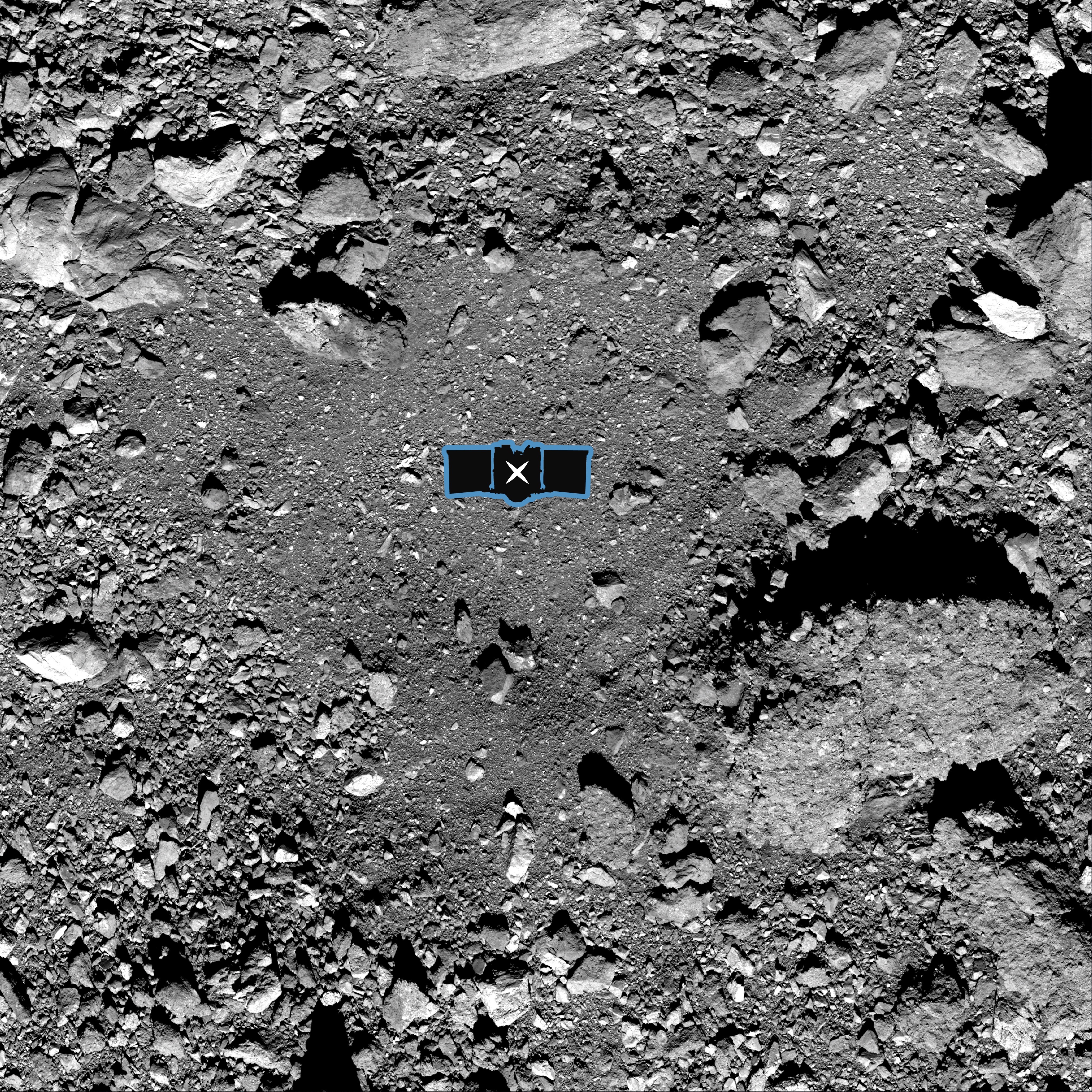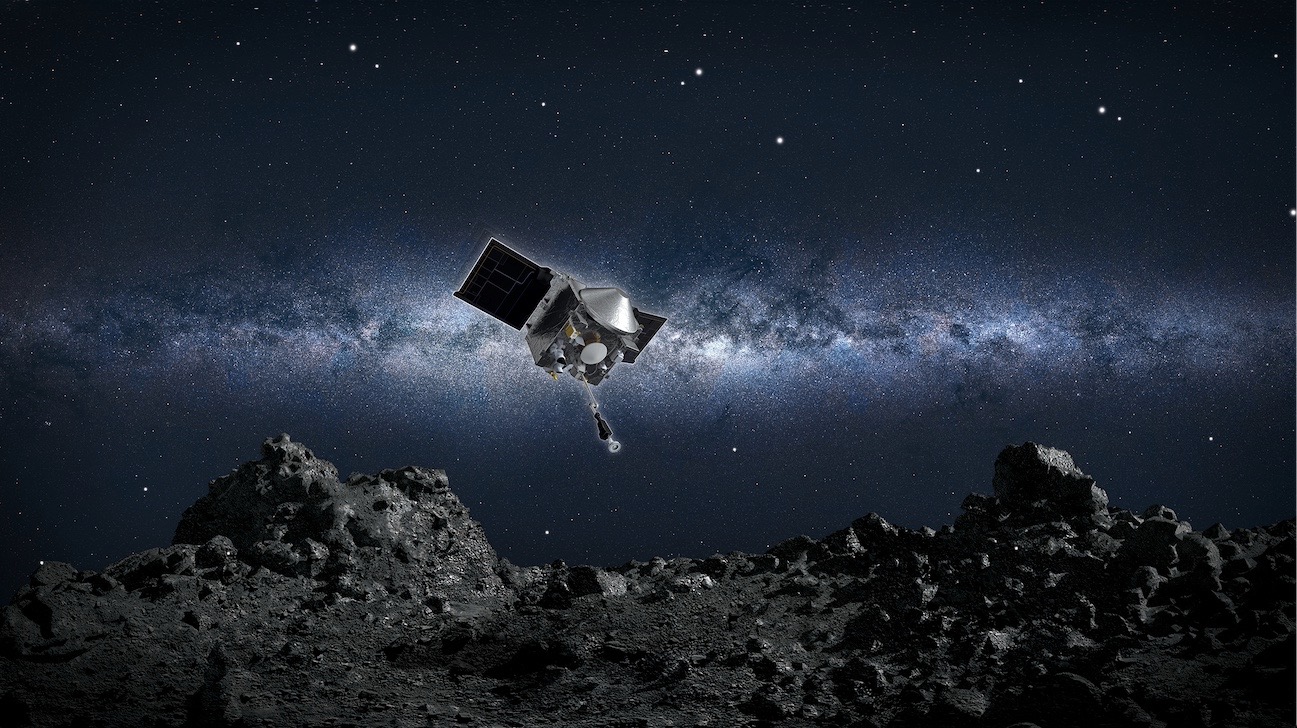NASA's OSIRIS-REx will play 'tag' with asteroid Bennu to collect samples today. But will it succeed?
NASA won't know for sure for 10 days.
Update for 6:58 pm ET: NASA's OSIRIS-REx spacecraft has successfully performed its asteroid Bennu sample-collection attempt, though it will take up to 10 days to determine if samples were actually captured. Read our full story and wrap up here.
Original story:
After more than a year of carefully mapping asteroid Bennu, a NASA spacecraft will attempt an historic "touch and go" to nab a precious sample of dirt to return to Earth. But we won't know if it fully succeeded for another 10 days, NASA officials said in a news conference on Monday (Oct. 19).
The OSIRIS-REx (Origins, Spectral Interpretation, Resource Identification, Security, Regolith Explorer) spacecraft will start its descent today (Oct. 20), and you can watch it live here on Space.com, courtesy of NASA Television. Since it takes about 18 minutes for signals to travel between the spacecraft and mission controllers on Earth, all maneuvers are programmed ahead of time and the spacecraft will be transmitting information as it goes along.
Early images from the asteroid will hint at whether the scoop succeeded, but it will only be by comparing the spacecraft's mass before and after the maneuver that engineers will finally know how much asteroid dirt is inside OSIRIS-REx. The maneuvers and analysis will take roughly 10 days, meaning the spacecraft's outcome won't be known until at least late October.
OSIRIS-REx: NASA's asteroid sample-return mission in pictures

But even the landing will be a journey for team members, some of whom have been participating in the mission planning for a dozen years or longer.
Get the Space.com Newsletter
Breaking space news, the latest updates on rocket launches, skywatching events and more!
"It will be four and a half hours of anxiousness," Beth Buck, OSIRIS-REx mission operations program manager at Lockheed Martin Space, said in a NASA-led news conference Monday (Oct. 19). That's as opposed to the typical "seven minutes of terror" associated with a Mars spacecraft descent, she added.
"The best outcome would be that we collect a massive sample," Heather Enos, OSIRIS-REx deputy principal investigator at the University of Arizona, said of what the team hopes to see in about 10 days, when data from the spacecraft's spin will show changes in mass that will indicate whether there is asteroid material ready inside for transport back to Earth in 2023.
While the mission design calls for 1.7 ounces (50 grams) of fine-grained material, there is room for up to 4.4 pounds (2 kilograms), Enos said. "I would love for that capsule to be completely full," she added.
Around 1:50 p.m EDT (1950 GMT) on landing day today (Tuesday, Oct. 20), controllers should receive telemetry from Bennu showing that the spacecraft departed from orbit. OSIRIS-REx will carefully maneuver twice more in two burns to get properly positioned for the surface and also, to verify it is on the right track to pluck a scoop of regolith.
A "checkpoint" burn will transmit information back to Earth around 5:50 p.m. EDT (2250 GMT), when the spacecraft is roughly 160 feet (50 meters) above the surface. Ten minutes later, OSIRIS-REx will transmit information from its third and final "matchpoint" burn that it will set it up for soft contact on the surface at 6:12 p.m. EDT (2312 GMT).
The descent will be more demanding than mission designers anticipated, with the prime sampling area — nicknamed "Nightingale" — only 52 feet (16 m) in diameter, Kenneth Getzandanner, OSIRIS-REx flight dynamics manager at the NASA Goddard Space Flight Center in Maryland, said in the news conference.

The original mission design called for a landing "zone" about 150% larger than Nightingale, at 82 feet (25 m), but Bennu proved to be more rocky than anyone expected, he said. Several months of precise laser mapping (down to a resolution of 2 inches, or 5 cm) and simulations followed to change OSIRIS-REx planning. Out of these discussions, the spacecraft will use enhanced guidance tracking to tweak the burn on the way to its target "tag" site, Getzandanner said.
At Nightingale, OSIRIS-REx will spend about 15 seconds attempting to gather material before rising into space again, Buck added. But there are ways to wave off the landing before touchdown if the area looks too rocky to make a safe collection. Buck said the spacecraft is automatically primed for aborts as high as 410 feet (125 m) and as low as 16 feet (5 m) above the surface.
The chances of a waveoff are less than 6%, she added. If an abort does happen, OSIRIS-REx will eventually sample a backup site, nicknamed "Osprey," that will be undisturbed by any spacecraft maneuvering. When to do that second attempt will depend on the health of the spacecraft, Buck added.

OSIRIS-REx's systems will be focused on a safe touchdown and only low-rate data, such as its position, will be transmitted back to Earth during and immediately after the descent. Some of the images should flow back sometime late on Tuesday or early on Wednesday. "We will know if we touched the asteroid, but we won't know if we have a sample," Enos said. What comes next will depend on if OSIRIS-REx truly gathered material, or not.
The spacecraft will rocket its precious cargo back to Earth in September 2023 for further analysis, with the aim of learning more about the small worlds that populate the small system. Applications of the collection will be diverse, including telling us more about the solar system's history, and helping future "planetary defense" engineers with making missions to protect Earth from rogue asteroids, missions that depend on knowing the composition of asteroids to best design deflection spacecraft.
"Something really amazing is about to happen tomorrow," Thomas Zurbuchen, NASA's associate administrator for the science mission directorate, said at the news conference. "I just couldn't be more excited to be a part of this team, and to be part of this amazing event."
Follow Elizabeth Howell on Twitter @howellspace. Follow us on Twitter @Spacedotcom and on Facebook.
Join our Space Forums to keep talking space on the latest missions, night sky and more! And if you have a news tip, correction or comment, let us know at: community@space.com.

Elizabeth Howell (she/her), Ph.D., was a staff writer in the spaceflight channel between 2022 and 2024 specializing in Canadian space news. She was contributing writer for Space.com for 10 years from 2012 to 2024. Elizabeth's reporting includes multiple exclusives with the White House, leading world coverage about a lost-and-found space tomato on the International Space Station, witnessing five human spaceflight launches on two continents, flying parabolic, working inside a spacesuit, and participating in a simulated Mars mission. Her latest book, "Why Am I Taller?" (ECW Press, 2022) is co-written with astronaut Dave Williams.









